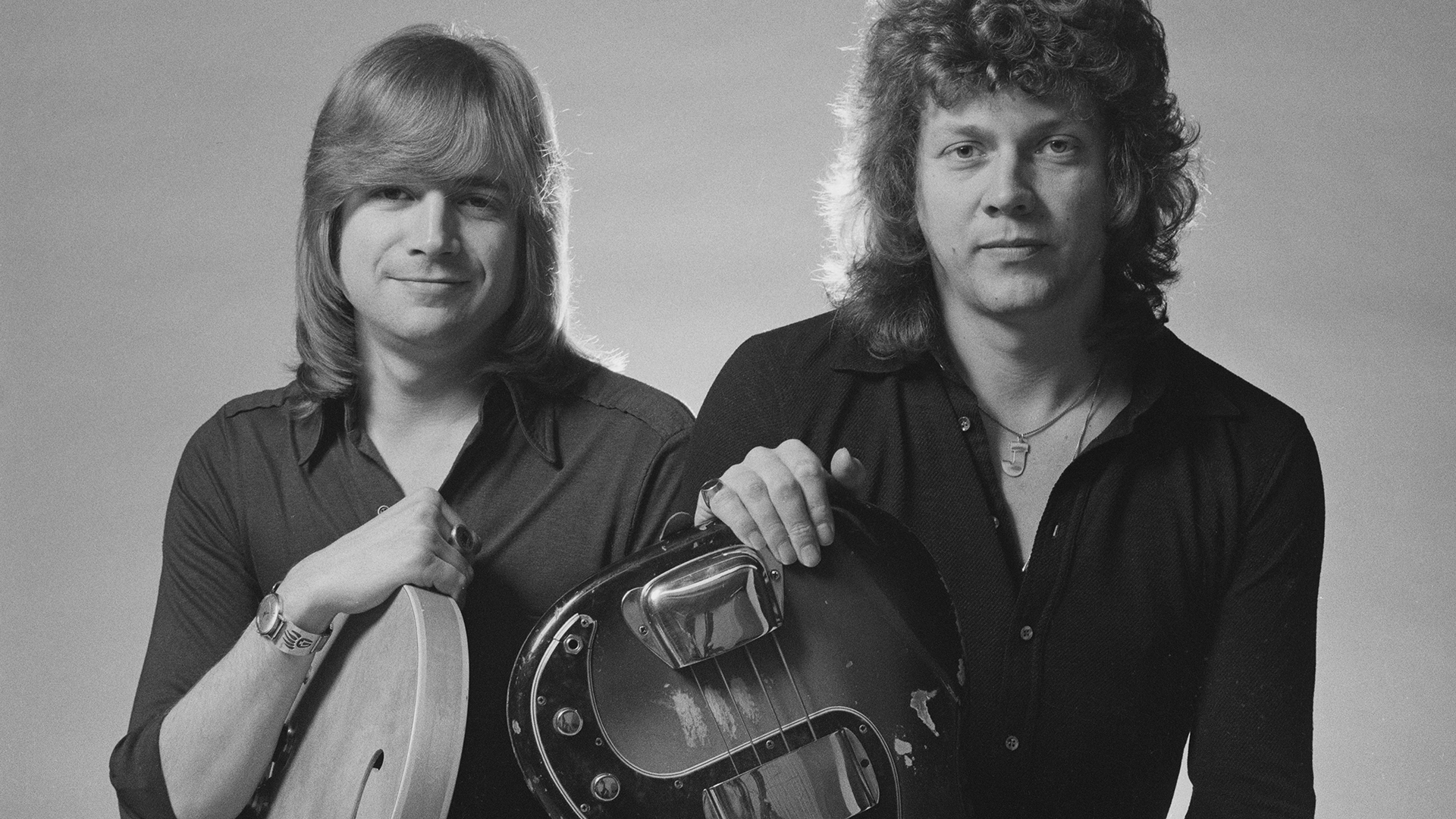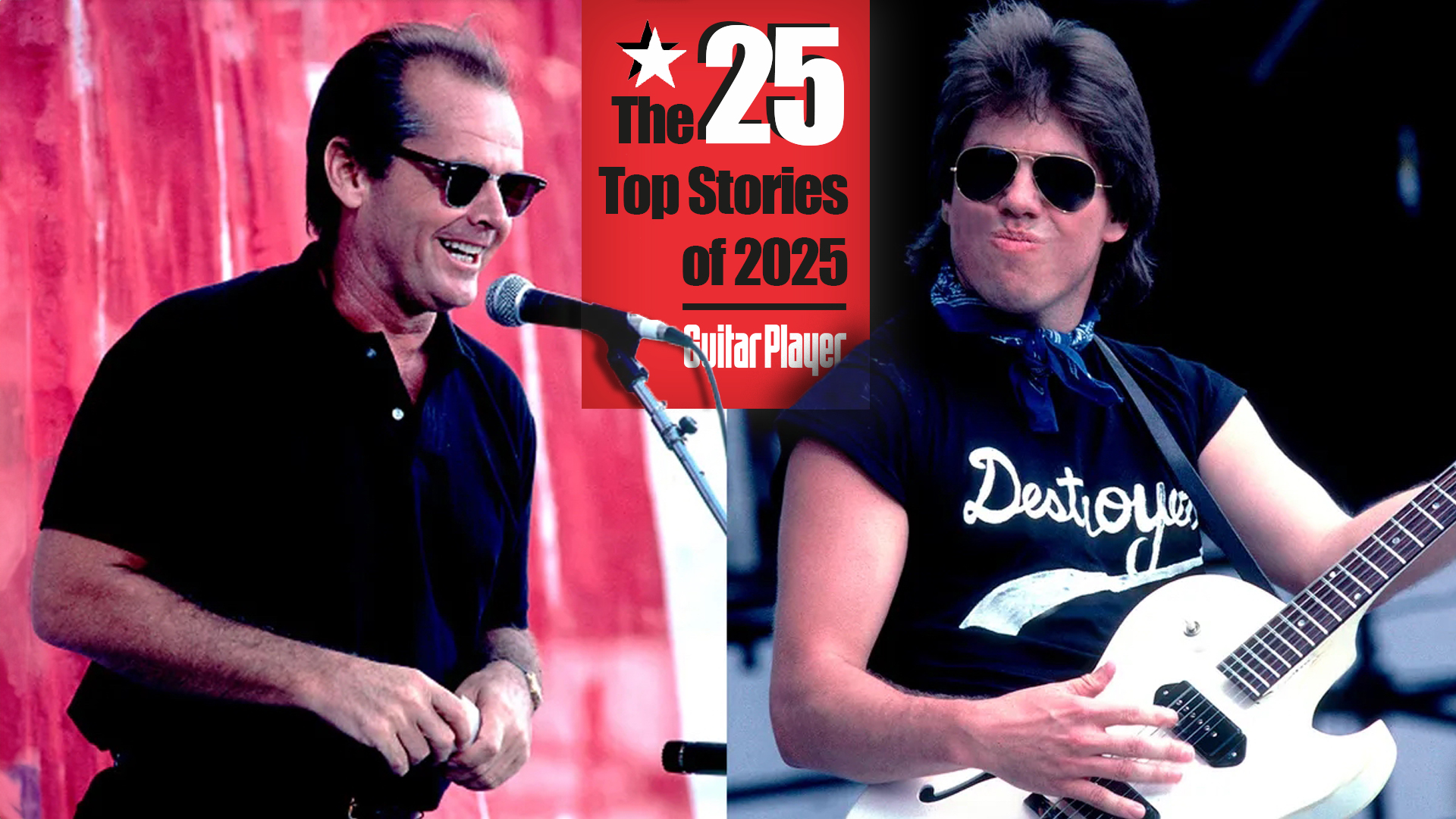“I sat on the side of the bed and just wrote the two verses. I was at the end of one big love affair and the beginning of another." Justin Hayward on the Moody Blues’ “Nights in White Satin” and the 12-string he got from Lonnie Donegan
The guitarist expounds on the virtues of guitar, saying, "It’s the perfect instrument to play and write with. You don’t need anything else"

“Songs kind of jump out of a guitar,” Justin Hayward notes via Zoom from his home in the south of France, where he splits time with his native England. He should know. Shortly after he discovered his beloved Gibson ES-335 — particularly the 1963 model he plays to this day — the Moody Blues guitarist from days of future passed had a magic guitar to begin writing songs on. It was a 12-string gifted to him by skiffle great Lonnie Donegan when he signed the then 17-year-old Hayward to a publishing deal (unfortunately lopsided, as so many were at the time). “It was the first nice guitar I’d had,” Hayward recalls. “A guitar is so rhythmic, so harmonic. It contains so many resonances within it. It’s the perfect instrument to play and write with. You don’t need anything else if you don’t want.”
Hayward, who bought the 12-string back after Donegan reclaimed it, did have plenty more to work with, however. With the Moodys he created a body of songs that was responsible for worldwide sales of more than 70 million albums and a dozen Top 40 hits in the U.S.. There was also the short-term Blue Jays project with Moodys bassist John Lodge — with whom Hayward had joined the band in 1966 — and, to date, seven solo albums. He has the reputation of a songwriting guitarist, but when the spirit takes hold he can cut loose as well. Evidence his solos on tracks such as “Ride My See-Saw,” “I’m Just a Singer (In a Rock and Roll Band)” and “The Voice.”
“That was always a bit of a dilemma to me,” Hayward says of those solos. “I was the only guitar player in the group, and doing the solos was just a joy. The only trouble was when I had to play those songs live: The bottom dropped out, ’cause I would stop playing the rhythm. That’s the dilemma for every guy who’s the only guitar player in a band. But I always loved to play a solo when the opportunity presented itself.”
These days Hayward does have another guitarist in his band — Mike Dawes, a fellow Brit who in 2016 became the first acoustic guitarist signed to an endorsement deal with DiMarzio and will be alongside as Hayward continues his Blue World Tour this fall in the U.K. The two have a large repertoire at their disposal, of course, but from that Hayward considers these the five songs that define a career that’s nearing the end of its sixth decade.
“Nights in White Satin” (1967)
“I wrote this song the summer before Days of Future Passed. It’s the only song from Days that was written before the recording sessions took place. I came home from one big night and sat on the side of my bed very early in the morning. I knew the other guys would expect me to have something to play the next day, because there was a session booked. They were always of the mind: ‘Oh, there’s a session booked. Justin will have something.’
“So with ‘Nights,’ I sat on the side of the bed and just wrote the two verses. I was at the end of one big love affair and the beginning of another. These are the things that boys, when they’re in the middle of love affairs, they think about. Every word in that song makes perfect sense to me, but trying to explain it to someone is difficult. [laughs] I mean, I lived every one of the lines in that song.
“I played it to everyone in the rehearsal room, and people were mostly indifferent. But then Mike [Pinder] said, ‘Play it again.’ He’d just gotten his Mellotron and he went [sings Pinder’s string-sample riff]. Suddenly everyone was interested and the song just seemed to make sense. It was a little bit of relief, you know? I was sure the other guys were thinking, We’ll get rid of this guy as soon as we can and move on, because if you’ve got nothing to offer, it doesn’t make any difference if you’re in or out. It’s always an interesting dynamic in a young group.”
All the latest guitar news, interviews, lessons, reviews, deals and more, direct to your inbox!
“Tuesday Afternoon” (1967)
“There was a lovely man at Decca called Hugh Mendl who really believed in the band. He was the reason, I suppose, why we were asked by Decca to do this demonstration record, a stereo record, with a theme. Between us, we decided it should be this story about the day in the life of one guy, and people started putting their hands up — ‘Right, I’ve got the afternoon. You’re good with that?’ And Hugh Mendl just absolutely loved it. He was an elderly gentleman among the guys, smoking a pipe. Such a sweet man.
“So once I got the afternoon, I went down to my parents’ house in Wiltshire, west England. I remember going into a field there with a guitar and writing ‘Tuesday.’ I was a bit hung up on tempo and changing keys, which ‘Tuesday’ does. It was the simplest thing to record, just a pure, good vibe from the writing through to playing it to the other guys — no stress, good vibe, all having a good time, thank you. Just three of us did the backing track, and I played the piano as an overdub and Mike did the Mellotron part, with that funny little trumpet on it that’s just so evocative.
“A friend of mine who’s a shock jock phoned me up one morning, live on air. He said, ‘What is this “gently swaying through the fairyland of love”?’ which is a line from ‘Tuesday Afternoon.’ I was completely baffled, like, ‘What?!’ It was like being back in school with somebody throwing a piece of chalk at me, expecting me to explain something.” [laughs]
“Question” (1970)
“That was another one of those ‘Justin will have something.’ I was living in a flat on the main road in Barnes, and I knew I was expected to have something the next day, which was a Saturday. So on Friday night I had two songs in this weird, big open tuning — maybe not so weird, but I wanted to write two different songs, but in completely different tempos. At the last minute I thought, I haven’t got one complete song, so I just put them together, and when I played it to everyone, nobody noticed. All the other guys just accepted it.
“It was written at a time when we were touring America, and a lot of young people of our generation were living in fear of being called up into a terrible conflict [the Vietnam War], so I think we were speaking for them in a way.
“When I wrote it, I knew what the bass line was going to be and what it needed from the drums, and fortunately I had Graeme [Edge], who could do that on the high hat. He was well up for doing that beat. And it was great — we didn’t do many takes. There’s no real double tracking on ‘Question.’ It was one of those things where we got back to basics. The Question of Balance album had that philosophy, to get back to basics and a simple way of recording.”
“Gemini Dream” (1981)
“‘Gemini’ was a jam session, as some songs often are. It was just myself, Graeme and John [Lodge], jamming. We just started this groove, this kind of four-on-the-floor beat, and then I came up with the guitar riff out of that. Then John and I wrote some lyrics to it. I didn’t think it was anything important at the time, but politically, in the group and everything, it was kind of the right thing to do.
“Long Distance Voyager was the first real album without Mike and our producer Tony Clarke. We had a very different crew — a different producer, different engineer — the whole thing. And a different keyboard player; Patrick Moraz’s contribution was going to be really big for the next few years. So ‘Gemini’ was the perfect thing to throw in there and start this new phase.”
“The Voice” (1981)
“It’s a guitar song — a rhythm guitar song. It was one of the first things I ever did with a click track, at home. Fortunately, Graeme was never one of those drummers who was like, ‘I don’t like click tracks or drum machines. I want to set the tempo!’ No, Graeme was great, fantastic, really took the pressure off me and said, ‘Sure, I’ll play on top of the click track.’ I knew it was a tempo that suited us, that suited the way I play guitar and the way Graeme and John played. It was like ‘The Story in Your Eyes.’ It was kind of safe.
“I remember exactly how [the solo] happened. It was my red ’63 ES-335, which of course I’ve still got, and is the greatest guitar in the world as far as I’m concerned. It’s kind of sweet and clanky at the same time, which 335s are. You stand in front of a Vox AC30 with the treble boosted in the Normal channel, full-up, and ‘The Voice’ is what it sounds like. That’s what comes out. ‘The Voice’ is another song that means a lot to me, every word. But don’t ask me to explain it, please. It just means a lot.”
Gary Graff is an award-winning Detroit-based music journalist and author who writes for a variety of print, online and broadcast outlets. He has written and collaborated on books about Alice Cooper, Neil Young, Bob Seger, Bruce Springsteen and Rock 'n' Roll Myths. He's also the founding editor of the award-winning MusicHound Essential Album Guide series and of the new 501 Essential Albums series. Graff is also a co-founder and co-producer of the annual Detroit Music Awards.
![The Moody Blues - Nights In White Satin [Original Footage] (1967) - YouTube](https://img.youtube.com/vi/88uv7S9Bz9U/maxresdefault.jpg)




